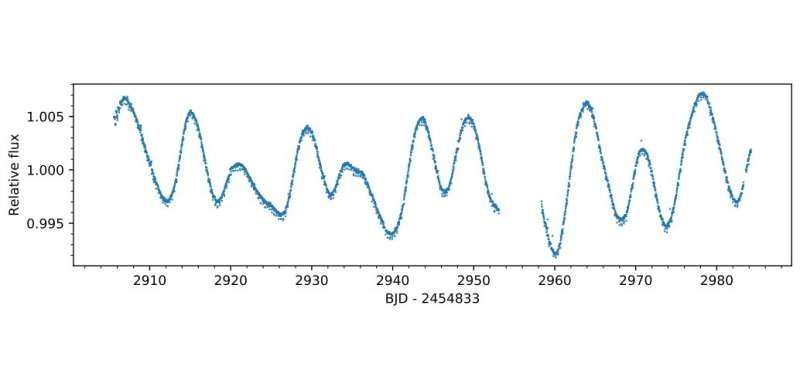November 20, 2017 report
'Super-Earth' planet with very short orbital period discovered

(Phys.org)—NASA's prolonged Kepler exoplanet-hunting mission, known as K2, has revealed the presence of another "super-Earth" alien world. The newly found planet, designated EPIC 246393474 b (or C12_3474 b), is more than five times more massive than the Earth and orbits its parent star in less than seven hours. The discovery is reported November 6 in a paper published on the arXiv pre-print repository.
Kepler is so far the most prolific planet-hunting telescope. The spacecraft has discovered more than 2,300 exoplanets to date. After the failure of its two reaction wheels in 2013, the mission was repurposed as K2 to perform high-precision photometry of selected fields in the ecliptic. Since then, the revived Kepler spacecraft has detected nearly 160 extrasolar worlds.
Researchers have used K2 to detect so-called "super-Earths" – planets with masses higher than Earth's but lower than that of the solar system's gas giants. In September, astronomers have confirmed the discovery of three super-Earths orbiting a nearby star, which were first spotted by this spacecraft. Now, an international group of researchers led by Oscar Barragán of the University of Turin in Italyusing K2 has detected one more such planet.
"In this paper we present the discovery of EPIC 246393474 b (hereafter C12_3474 b), an ultra-short-period planet transiting a K7 V star," the astronomers wrote in the paper.
The Kepler spacecraft observed a K-type main sequence star known as EPIC 246393474 from December 2016 to March 2017 during its Campaign 12. The star is about 740 million years old with a radius and mass approximately 33 percent smaller than that of the sun.
As a result of these observations, the researchers identified a transit signal in the light curve of this star. The planetary nature of this signal was later confirmed by follow-up observational campaign using ground-based telescopes, including the WIYN 3.5-Meter Telescope at Kitt Peak National Observatory in Arizona.
According to the study, EPIC 246393474 b has a radius of 1.54 Earth radii and is 5.3 times more massive than our planet, indicating a density of approximately 8.0 g/cm3 and suggesting a rocky-iron composition. The exoplanet has an equilibrium temperature of 2,039 K.
"The planetary density is consistent with a composition made of a mixture of iron and rocks. We estimated that the iron content of C12_3474 b cannot exceed about 70 percent of the total planetary mass," the paper reads.
What is most interesting about EPIC 246393474 b is that it has an ultra-short orbital period. Barragán's team found that it orbits its host every 6.7 hours at a distance of about 0.007 AU. This makes it the shortest-period planet known to date with a precisely determined mass.
The researchers noted that the close distance of EPIC 246393474 b to its parent star suggests that it has lost its entire atmosphere due to stellar irradiation. However, they added that further mass measurements of transiting ultra-short-period planets should be performed in order to confirm this theory.
More information: EPIC 246393474 b: A 5-M⊕ super-Earth transiting a K7 V star every 6.7 hours, arXiv:1711.02097 [astro-ph.EP] arxiv.org/abs/1711.02097
Abstract
We report on the discovery of EPIC 246393474 b, an ultra-short-period super-Earth on a 6.7-hour orbit transiting an active K7 V star based on data from K2 campaign 12. We confirmed the planet's existence and measured its mass with a series of follow-up observations: seeing-limited MuSCAT imaging, NESSI high-resolution speckle observations, and FIES and HARPS high-precision radial-velocity monitoring. EPIC 246393474 b has a mass of 5.31±0.46 M⊕ and radius of 1.54+0.10−0.09 R⊕, yielding a mean density of 8.00+1.83−1.45 gcm−3 and suggesting a rocky-iron composition. Models indicate that iron cannot exceed ∼70 % of the total mass. With an orbital period of only 6.7 hours, EPIC 246393474 b is the shortest-period planet known to date with a precisely determined mass.
© 2017 Phys.org




















